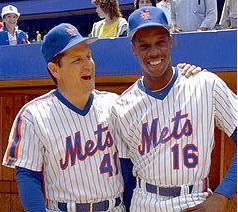
The Mets have always done a good job at giving us a heads-up of when good times are around the corner.
The Mets’ history spans over a half-century, and has had its fair share of turmoil and disappointment. In between the painful stretches, however, the team and its fans have enjoyed bursts of success. And as we all know, the Mets are due for one of those bursts.
Dating back to the team’s first taste of victory in the late 1960s, the Mets have always given us steady notice of when good times are on the way. In the mid-60s, it was Tom Seaver and Jerry Koosman warming in the wings. The righty-lefty duo eventually formed the top two-fifths of the Mets rotation by 1969, when New York won it all in its seventh season as a franchise. Seaver won 198 ballgames in blue and orange, and Koosman 140.
From 1968-1970, the two combined for a 107-59 record. Seaver pitched to a 2.42 ERA in that stretch, and Koosman 2.46. The pitching twosome was nothing short of amazin’ during the team’s first streak of victory, and their 1967 arrivals marked that period. From ’69-’73, the team finished above .500 in each season—the first five winning seasons in franchise history. More importantly, however, were the two World Series the Mets reached in those years. The original Amazin’s shocked much of the baseball world, but as history would soon point out, maybe we shouldn’t have been all that surprised.
The early 1980s are largely remembered as the darkest age of Mets history. The team never won more than 68 games in any season from 1977 to 1983. There was another couple of home-grown studs on the rise, though, that would turn the gloomiest era of Mets baseball into the very best.
In 1983, a lanky power-hitting outfielder from California took Flushing by storm. Darryl Strawberry’s rookie season included 26 bombs, 74 RBIs, an .848 OPS, and eight outfield assists. Straw took home Rookie of the Year honors in a season that was otherwise uneventful for the last-place Mets.
The next season though, the second half of the young pair arrived in the bigs, and that’s an understatement. Dwight Gooden debuted on April 4 of that year, and from that day forward he would be a household name in the baseball world. The Doctor became the second consecutive Met to win Rookie of the Year. 1984 was a very different season for the Mets, however. The new-look Mets won 90 games that year, but fell short of reaching the playoffs. They wouldn’t dip under the 90-win mark again for another five years.
From 1985-1988, the Mets were the National League’s new power house. Their second championship wasn’t far removed from seasons of futility—much like their first. Also like the team’s first World Series victory, a set of two hot farmhands transformed the squad from laughing stock to champion.
The third pair of Mets studs didn’t blossom until the mid-2000s. Unlike the previous two sets of soothsayer prospects, this one came on the heels of a World Series appearances relatively soon before. The Mets reached the series in 2000, only to reach the depths of the NL East cellar by 2002.
The franchise was in need of rescue a bit earlier than expected, but, as we’d soon find out, it would be in capable hands. A 19-year-old shortstop out of the Dominican Republic made the first half of Shea Stadium’s final revival-marking pair. Jose Reyes got the call to the bigs in 2003, and although his rookie campaign was cut short due to injury — and the team couldn’t escape the basement — Mets fans couldn’t help but feel a sense of optimism.
And for good reason. Thirteen months following Reyes’ promotion, David Wright, the 21-year-old infielder out of Virginia, walked into the Shea Stadium clubhouse for the first time. The moment the home-grown, youthful duo made their way to the left side of second base together, we should’ve known what was to come; we’d seen it twice before. It wasn’t long before the Mets were back on the map.
Less than two full seasons, to be exact. By 2006, the Mets were the cream of the MLB crop. Headed by key free agent signings, and their remarkable pair of All-Star infielders, “Los Mets” came out victorious 97 times that year — the most dominant since the Doc and Darryl days. Led by Reyes, they danced their way all the way to Game 7 of the NLCS, where fate would deny them a chance for a third World title.
Though there was no title this time, you could argue that the 2006 Mets were the most fun Mets team to watch—especially to the younger generation. 2007 and 2008 followed, both filled with tremendous victory totals, but no playoff appearances to show for it.
So, here we are.
2013: Closing in on seven years since the last Mets playoff game. We’ve encountered it all: an injured starting nine, free agent busts, managerial switches, broke owners — and just flat-out futility. Right about now would be a good time for Mets fans to give up; that is, if we didn’t pay attention to our club’s history.
After four consecutive fourth-place finishes, we haven’t seen the Mets win more than 80 games since 2008. And even though there hasn’t been a significant free agent pickup in nearly five offseasons, the only thing we do have is hope. Why? Because we’ve found our prospect pair —better yet, a prospect trio.
Last season, we got out first taste of Matt Harvey, a power righty out of UNC. We were mesmerized by his competitiveness at such a young age — on such a bad team. The most encouraging part about Harvey is that he may not even be the best of what’s to come.
The Mets had a future Hall-of-Famer in Carlos Beltran. But once the glass slipper no longer fit, Beltran was swapped for the Mets’ next World Series piece — and the second piece to the team’s next talent influx — Zack Wheeler.
Wheeler is due for a mid-2013 call-up. The 6’4″ righty will likely pilot the Mets rotation for years to come, with Harvey right on his heels. And as if this duo wasn’t enough cause for celebration among the Mets community, just let this sink in:
They could be pitching to the next Mike Piazza.
Travis D’Arnaud was acquired for New York’s adopted 38-year-old son, R.A. Dickey. After a miraculous Cy Young-worthy season, Dickey was painfully dealt to Toronto. D’Arnaud, however, will be the perfect remedy for Mets fans’ angst.
D’Arnaud is viewed as MLB-ready right now. He’ll likely give it one last go-around in Triple-A this April until the Mets make the call for their catcher of the future. His bat, according to what you read, is the best we’ve seen of any catcher from this generation. Not long after his call should be that of Wheeler. From there, all we have to do as fans is wait for the newest age of Mets marvels grow.
And don’t get too comfortable waiting. If history has it right, it won’t be long before the triple-threat of Mets talent has Citi Field at the heart of the baseball world.













